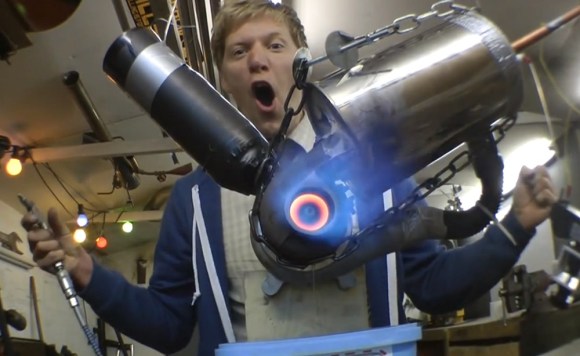Turbo charger Jet Engines have long been considered one of the holy grails of backyard engineering. This is with good reason – theyre hard to build, and even harder to run. Many a turbo has met an untimely end from a hot start or oil starvation. [Colin Furze] however, makes it look easy. [Colin] is a proponent of crazy hacks – weve featured him before for his land speed record holding baby carriage, and his pulse jet powered tea kettle.
In his latest video set, [Colin] takes a toilet brush holder, a toilet paper roll holder, a few plumbing fittings, and of course a small turbocharger from the scrap yard. Somehow he converts all of this into a working jet engine. The notable thing here is that there is no welding. Some of the joints are held together with nothing more than duct tape.
Calling this a working jet engine is not really an overstatement. As every backyard jet jockey knows, the first goal of DIY jets (aside from not hurting yourself) is self-sustaining. Turbines are spun up with air hoses, vacuums, or leaf blowers. The trick is to turn the fuel on, remove the air source, and have the turbine continue spinning under its own power. Once this happens, your engine is performing the same Suck, Squeeze, Bang, Blow combustion process an F-18 or a 747 uses.
All this doesn’t mean the engine can do anything useful beyond keep itself running. This is where the second goal of backyard jet engines come in – thrust. You need a usable amount of thrust before you can strap that engine to a go-cart and go cruising around the neighborhood.
[Colins] jet is built and tested over a two video set. the first outlines how to build it, and the second shows the jet running. As a safety note, [Colin] has hinted in the YouTube comments that there will be a third video in the series showing how he had an incident with a gas leak, and it led to him being put out of action for a week. Needless to say – dont try this particular engine build at home.
[Thanks James!]
Filed under: Engine Hacks

+ Reply to Thread
Results 1 to 1 of 1
-
10-05-2013, 09:35 AM #1
(Please Dont) Build a Jet Engine from a Toilet Paper Holder
Thread Information
Users Browsing this Thread
There are currently 1 users browsing this thread. (0 members and 1 guests)





 Reply
Reply
Bookmarks